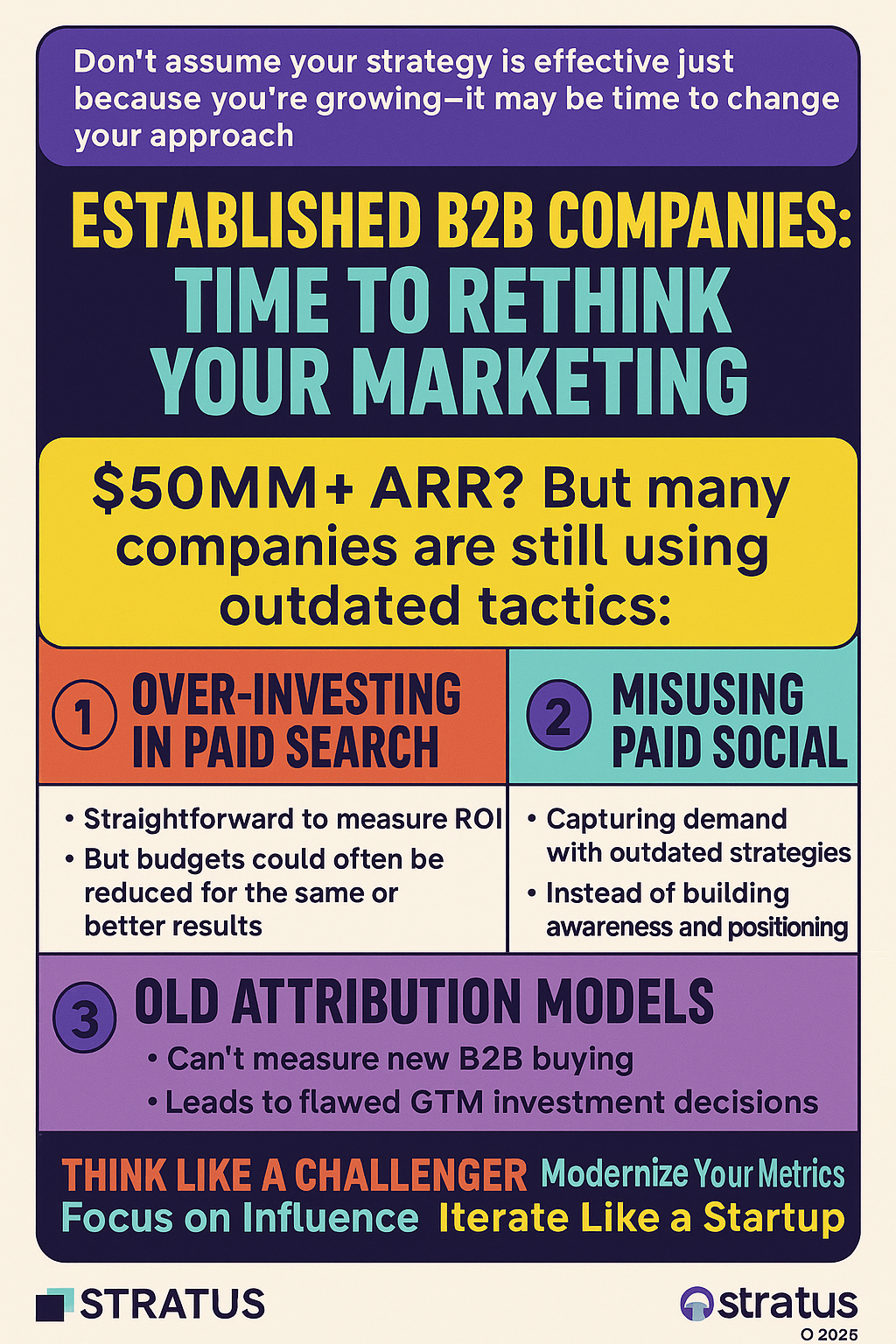When we think of marketing innovation, startups often steal the spotlight. Scrappy teams, fresh ideas, lean budgets—they’re forced to be creative and tactical from day one. But here’s the irony: it’s not the startups that should be most concerned about their outdated marketing tactics.
It’s the established players.
We’re talking about B2B companies doing $50M+ in ARR, with large teams, years of traction, and reliable growth. But too often, these companies are still operating with a “what’s always worked” mindset—even if market dynamics, buyer behavior, and competitive pressure have changed entirely.
In this post, we’ll dig into:
- The 3 biggest marketing blind spots we see in established B2B companies
- Why legacy success creates risk
- What tactical shifts these companies can make now to future-proof growth

The Legacy Trap: Growth Doesn’t Mean You’re Doing It Right
It’s a common narrative:
- You’ve grown steadily for years.
- Your sales and marketing engines are humming.
- There’s budget to burn.
- You’ve had campaigns that produced reliable leads.
So what’s the problem? It’s your outdated marketing tactics!
Success breeds complacency.
Many established brands assume their strategy is sound simply because they’re growing. But growth can mask inefficiencies, outdated tactics, and untapped opportunities. Here’s where we see it show up most:
1. Over-Investing in Paid Search (Google Ads) Without Optimization
Paid search is one of the most measurable, controllable channels in B2B. That’s exactly why companies love it—and over-rely on it.
Here’s what’s happening:
- Budgets keep increasing because “it’s easy to prove ROI.”
- Companies compete on bottom-of-funnel keywords that get pricier every year.
- They neglect the upper funnel or more creative brand-building tactics.
But often, these companies could cut spend by 30–50% and get the same or better pipeline if they:
- Prune underperforming keywords
- Audit conversion quality (not just volume)
- Shift focus to pipeline contribution, not just lead generation
- Fix poor landing pages that hemorrhage conversion
✅ Actionable Tips:
- Run a zero-based budget audit: Start fresh—what would you fund today if your current campaigns didn’t exist?
- Pause brand keywords temporarily: See how much “organic” demand you’re cannibalizing.
- Apply deeper segmentation: Separate campaign performance by deal size, industry, or lifecycle stage to focus on high-quality traffic.
- Tie conversion actions to actual sales pipeline, not just MQLs.
2. Misusing Paid Social as Just Another Demand Capture Tool
Too many large B2B brands treat LinkedIn, Facebook, and other paid social like another Google Ads clone. The focus is on bottom-of-funnel conversion ads rather than leveraging these platforms for brand positioning, education, and influence.
In the current B2B landscape, buying cycles are long and complex. Decision-makers are influenced long before they hit a demo form.
Paid social should be about:
- Getting in front of your target market early
- Shaping how your brand is perceived
- Creating memorable, helpful content that earns trust
If your paid social strategy is “lead gen or bust,” you’re burning budget—and missing opportunity.
✅ Actionable Tips:
- Build native content campaigns that look like thought leadership, not sales pitches.
- Use video and storytelling to create emotional connection and clarity about your product category.
- Measure engagement velocity: How quickly is your content reaching new ICP members and drawing return visits?
- Develop sequences: Run sequential messaging campaigns that move people from awareness to consideration over time.
3. Relying on Outdated Marketing Tactics and Attribution Models
Multi-touch attribution, last-touch attribution, linear attribution—most enterprise-level B2B firms are still clinging to models that don’t reflect how buying actually works today.
Buyers are:
- Learning from peers on Slack groups
- Influenced by podcast mentions
- Discovering you from LinkedIn comment threads or Reddit forums
None of these touchpoints get captured in classic attribution models. As a result, teams end up:
- Underfunding brand and community
- Over-prioritizing click-based channels
- Misjudging the actual ROI of their GTM investments
✅ Actionable Tips:
- Use self-reported attribution fields on demo forms: “How did you hear about us?” often yields better insight than an analytics platform.
- Layer in qualitative signals from your sales team—ask what prospects reference on intro calls.
- Analyze assisted conversions rather than just last-click—who engaged with what before converting?
- Model ROI with triangulation, not tunnel vision: Combine attribution data with sales input and platform-level insights to make better investment decisions.
What Happens When Enterprise Brands Don’t Adapt?
Failing to modernize your marketing strategy doesn’t just hurt performance—it puts you behind your more agile, faster-moving competitors. Startups are beating enterprise players not with more budget—but with more relevance.
They’re:
- Talking where your buyers are listening
- Educating in ways that don’t feel like selling
- Building brand affinity before a need even exists
If you don’t think critically about your strategy just because you’re growing, you might wake up one day to find your market perception has shifted without you.
How to Start Fixing It: A Quick Playbook
Here’s a simple way to begin shifting your mindset:
🧠 Think Like a Challenger
Just because you’ve “made it” doesn’t mean you’re immune. Constantly question your go-to-market assumptions.
📊 Modernize Your Metrics
Start tracking what matters: buying intent, brand engagement, sales velocity—not just MQLs or last-click ROI.
🔍 Focus on Influence, Not Just Clicks
You’re not just capturing demand. You’re creating it. Position your brand at every layer of the awareness journey.
🚀 Iterate Like a Startup
Run experiments. Kill deadweight campaigns. Test creative, unscalable tactics like community drops or podcast partnerships.
Final Thought
Success doesn’t protect you from disruption—it often invites it. B2B companies with $50MM+ ARR have everything to lose by coasting on outdated marketing strategies.
If you want to win in 2025 and beyond, start now:
- Audit your media mix.
- Invest in branding, not just performance.
- Measure smarter, not just harder.
Don’t let legacy momentum become legacy thinking.

Hi there! I’m Scott, and I am the principal consultant and thought leader behind Stratus Analytics. I have a Master of Science degree in marketing analytics, and I’ve have been providing freelance digital marketing services for over 20 years. Additionally, I have written several books on marketing which you can find here on Amazon or this website.
DISCLAIMER: Due to my work in the packaging industry, I cannot take on freelance clients within the packaging manufacturing space. I do not want to provide disservice to your vision or my employer. Thank you for understanding.
